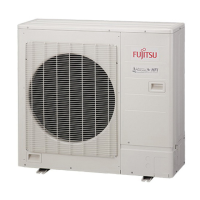Vaccum process7. 2.
CAUTION
Perform a refrigerant leakage test (air tightness test) to check for leaks using nitrogen gas while all valves in the •
outdoor unit are closed. (Use the pressure indicated on the nameplate.)
Be sure to evacuate the refrigerant system using a vacuum pump.•
The refrigerant pressure may sometimes not rise when a closed valve is opened after the system is evacuated •
using a vacuum pump. This is caused by the closure of the refrigerant system of the outdoor unit by the
electronic expansion valve. This will not affect the operation of the unit.
Ifthesystemisnotevacuatedsufciently,itsperformancewilldrop.•
UseacleangaugemanifoldandcharginghosethatweredesignedspecicallyforusewithR410A.Usingthe•
same vacuum equipment for different refrigerants may damage the vacuum pump or the unit.
Do not purge the air with refrigerants, but use a vacuum pump to evacuate the system.•
Check that the valves are closed by removing the blank caps from the gas and liquid pipes. 1)
Remove the charging port cap, and connect the gauge manifold and the vacuum pump to the charging 2)
valve with the service hoses.
Vacuum the indoor unit and the connecting pipes until the pressure gauge indicates –0.1 MPa (500microns). 3)
When –0.1 MPa (500microns) is reached, make sure it hold vacuum for 60 minutes. 4)
Disconnecttheservicehosesandtthechargingportcaptothechargingvalvetothespeciedtorque. 5)
(Refer to below table)
Remove the blank caps, and fully open the 3-way valves with a hexagon wrench [Torque: 6 to 7 N·m 6)
(4.4 to 5.2 lbf·ft)].
Tightentheblankcapsofthe3-wayvalvetothespeciedtorque. 7)
Tightening torque [N·m (lbf·ft)]
Charging port cap
10 to 12 (7.4 to 8.8)
3-way valve
6 to 7 (4.4 to 5.2)
Blank cap
[mm (in.)]
Tightening torque
[N·m (lbf·ft)]
6.35 (1/4) 20 to 25 (14.8 to 18.4)
9.52 (3/8) 20 to 25 (14.8 to 18.4)
12.70 (1/2) 25 to 30 (18.4 to 22.1)
15.88 (5/8) 30 to 35 (22.1 to 25.8)
19.05 (3/4) 35 to 40 (25.8 to 29.5)

